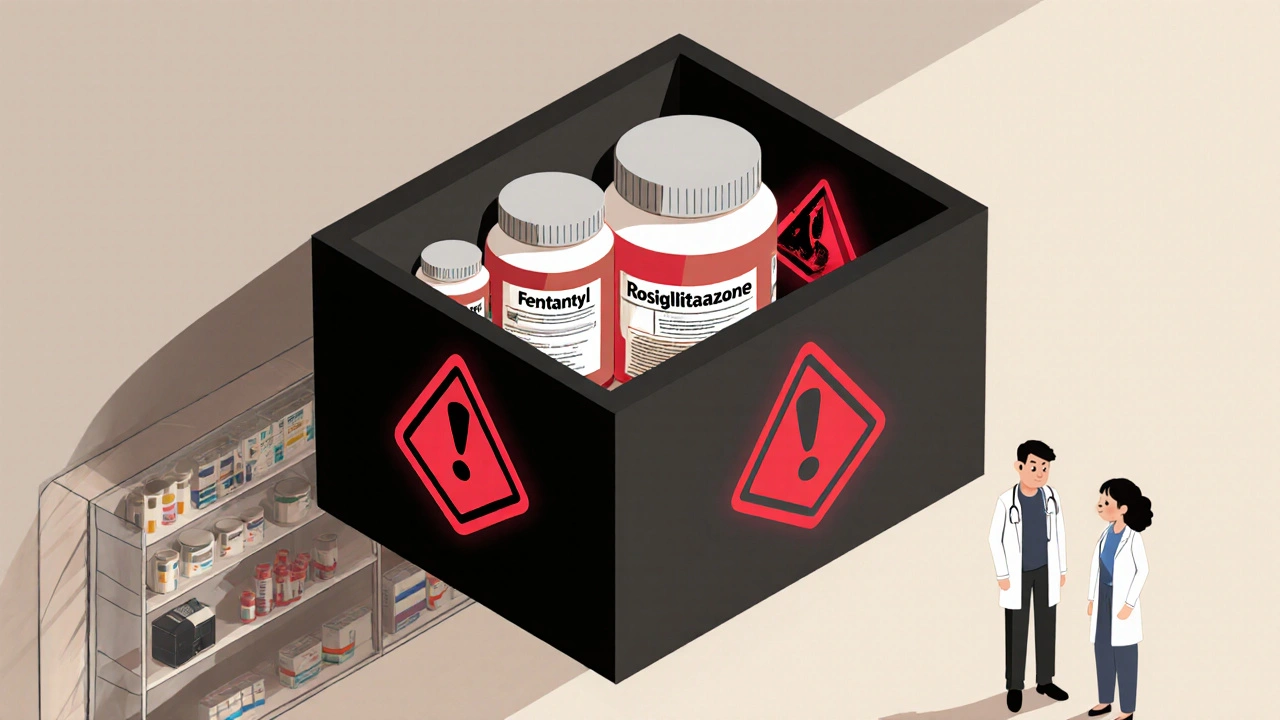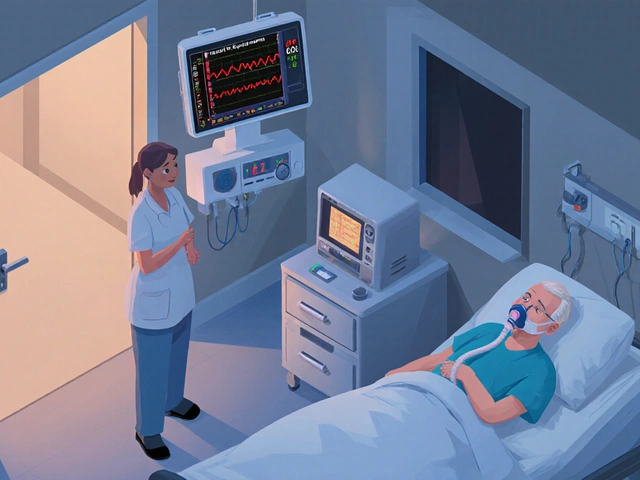Black Box Warnings: What You Need to Know About the FDA’s Strongest Drug Safety Alerts

When a drug comes with a black box warning, it’s not just a caution-it’s a red flag. This isn’t a small note tucked at the bottom of a prescription label. It’s a bold, black-bordered box at the very start of the drug’s official documentation, screaming: this could kill you. The U.S. Food and Drug Administration (FDA) uses these warnings only when the evidence shows a real, serious risk of death or life-threatening injury. And right now, more than 400 prescription medications carry one.
What Exactly Is a Black Box Warning?
A black box warning is the highest level of safety alert the FDA can issue for a prescription drug. It’s not a suggestion. It’s a requirement. The FDA mandates it when clinical studies, post-market reports, or real-world data show that a drug can cause severe, sometimes fatal, side effects. These aren’t rare glitches. They’re predictable, documented dangers that happen often enough to demand immediate attention from doctors and patients. The warning appears in three places: the drug’s package insert (the full prescribing information), the patient labeling, and any promotional materials. It’s always in a thick black border, making it impossible to miss. Inside, it doesn’t just say “may cause side effects.” It says exactly what the risk is: increased risk of suicidal thoughts in young adults, life-threatening liver damage, fatal heart rhythm problems. These warnings didn’t always exist. The FDA started requiring them after the Kefauver-Harris Amendments of 1962, which forced drug companies to prove their products were not just safe, but effective. The black box format itself evolved later, becoming the standard way to highlight the most dangerous risks. Today, it’s the most serious signal in drug safety communication-above regular warnings, precautions, and contraindications.Why Do Some Drugs Get a Black Box Warning?
The FDA doesn’t slap these on lightly. They’re reserved for three main scenarios:- The risk is so severe that it might outweigh the benefits for some patients-like a diabetes drug that increases heart failure risk.
- The harm can be reduced if the drug is used exactly right: with regular blood tests, avoiding certain other medications, or only in specific age groups.
- The drug requires special restrictions-like mandatory training for prescribers, or bans on use in pregnant women or children.
How Does the FDA Decide to Add a Black Box Warning?
Most people think the FDA checks everything before a drug hits the market. That’s not true. Many black box warnings come after approval. That’s because some risks only show up when thousands or millions of people use the drug over years. The process starts with lab studies and animal testing. Then come clinical trials-usually a few thousand people over months or a couple of years. But real life is messier. Once the drug is out there, doctors start prescribing it to older patients, people with kidney disease, those on five other medications. That’s when unexpected reactions pop up. The FDA tracks these through the FDA Adverse Event Reporting System (FAERS). Anyone-patients, doctors, pharmacists, even drug companies-can report side effects. When enough reports point to the same danger, the FDA investigates. If the data is strong enough, they require the manufacturer to add a black box warning. For example, the diabetes drug rosiglitazone got a black box warning in 2007 after studies linked it to heart attacks. Sales dropped by 70% in a year. But another similar drug, pioglitazone, had a similar warning and didn’t see the same drop-because it got less media attention. That tells you something: warnings alone don’t change behavior. Awareness does.What Should You Do If Your Medication Has a Black Box Warning?
First, don’t panic. A black box warning doesn’t mean the drug is banned or useless. It means you need to be smart about using it. Talk to your doctor. Ask:- What’s the exact risk?
- How likely is it to happen to me?
- Are there monitoring tests I need-like blood work or heart scans?
- Are there safer alternatives?
- What signs should I watch for at home?
How Effective Are These Warnings?
The answer is: it depends. Some black box warnings change prescribing habits dramatically. Rosiglitazone’s warning cut its use by 70%. Others? Not so much. A 2022 analysis found that many doctors still prescribe drugs with black box warnings without fully discussing the risks with patients. Why? Time pressure. Lack of training. Assumptions that “everyone knows.” Patients often don’t understand the warnings either. A black box doesn’t tell you your personal risk-it just says “this can kill.” That’s why experts are pushing for clearer language: instead of “risk of death,” say “1 in 200 people may die from this side effect.” Numbers stick better than scare tactics. The FDA admits this. Their 2011 guidance document says they’re working on better ways to communicate risk-more precise, more patient-friendly. But for now, the black box remains the strongest tool they have.
What’s Next for Black Box Warnings?
The system isn’t perfect, but it’s essential. More drugs are getting warnings every year-especially psychiatric meds, painkillers, and diabetes treatments. The FDA is also paying closer attention to drugs used by older adults and people with multiple conditions, where interactions are harder to predict. Patient advocacy groups are pushing for faster warnings. In 2023, a group petitioned the FDA to add a black box to a common osteoporosis drug after reports of unusual jaw bone damage. The FDA reviewed the data and added the warning within six months. Meanwhile, pharmaceutical companies are learning to live with them. A black box can tank sales, but if the drug treats a life-threatening condition-like cancer or severe epilepsy-it still gets prescribed. Doctors know the risks. Patients who understand them are more likely to stick with the treatment. The future might include digital alerts in electronic health records, or pop-up warnings when a doctor tries to prescribe a black box drug. But for now, the black border is still the clearest signal: pay attention.Where to Find More Information
If you want to check whether your medication has a black box warning, look at the official prescribing information. You can find it on the FDA’s website or through reliable sources like the Drug Effectiveness Review Project or Consumer Reports Best Buy Drugs. If you experience a side effect, report it. The FDA’s MedWatch program lets anyone submit reports online. These reports help them spot new dangers. Your voice matters.What If You’re Prescribed a Drug With a Black Box Warning?
Ask yourself three things:- Is this drug the only option? Are there alternatives without such a serious warning?
- Can the risk be monitored? Will I need regular blood tests, EKGs, or check-ins?
- Do I understand what to do if something goes wrong?
What does a black box warning mean for my health?
A black box warning means the FDA has found strong evidence that this drug can cause serious, life-threatening side effects. It doesn’t mean you can’t take it-it means you and your doctor need to weigh the risks against the benefits carefully. You may need regular monitoring, avoid certain other medications, or be aware of specific warning signs.
Do all drugs with black box warnings cause harm?
No. A black box warning highlights a serious potential risk, but that risk doesn’t happen to everyone. For example, many people take antidepressants with black box warnings and never experience suicidal thoughts. The warning is there because the risk is real enough to require attention-not because it’s guaranteed to happen.
Can I stop taking a drug if it has a black box warning?
Never stop a prescription medication on your own, even if it has a black box warning. Stopping suddenly can be dangerous-especially for drugs like antidepressants, seizure medications, or blood pressure pills. Always talk to your doctor first. They can help you taper off safely or switch to a different treatment.
How do I know if my doctor knows about the warning?
Ask them. A good doctor will explain the warning, why they chose this drug, what risks to watch for, and what monitoring is needed. If they can’t answer your questions clearly, consider getting a second opinion. You have the right to understand your treatment.
Are black box warnings only for prescription drugs?
Yes. Black box warnings only apply to prescription medications approved by the FDA. Over-the-counter drugs, supplements, and vitamins don’t carry them. That’s why it’s especially important to tell your doctor about everything you’re taking-even herbal supplements-because they can interact dangerously with black box drugs.






Comments (10)
Stephen Adeyanju
27 Nov 2025
So my grandma’s on a black box drug and she’s fine but her neighbor died from it and now she won’t even take her blood pressure med 😭
Aaron Whong
28 Nov 2025
The black box warning paradigm represents a hermeneutic of risk commodification within the biomedical hegemony. It’s not merely a regulatory artifact-it’s a semiotic rupture in the patient-provider epistemic contract, wherein pharmacological agency is ontologically reified through the performative power of the FDA’s orthographic terror.
By imposing a visually coercive lexical enclosure, the FDA enacts a Foucauldian dispositif of biopower, rendering the patient as a docile body surveilled by the specter of mortality encoded in Helvetica Black. The warning, in its stark typographic absolutism, functions not as information but as affective inoculation-preemptively inoculating the pharmaceutical-industrial complex from liability while simultaneously pathologizing therapeutic compliance.
What’s fascinating is how this mechanism mirrors neoliberal governance: risk is externalized, individualized, and then monetized. The patient is told to ‘be informed’-but never given the tools to contextualize the statistical probability of death. It’s performative safety. Aesthetic deterrence. A black box not to inform, but to absolve.
The real tragedy? We’ve normalized this. We scroll past it like a TikTok ad. The FDA didn’t create fear-they just gave fear a border. And now we treat the border like the boundary of truth.
Meanwhile, the drugs that kill the most people-opioids, antipsychotics, NSAIDs-still don’t all have them. Why? Because the market demands them. The black box is a luxury. Only for the drugs that can afford the PR hit.
Sanjay Menon
30 Nov 2025
How quaint. The FDA still thinks a black border and three sentences of legalese constitutes ‘risk communication.’ In Europe, we use risk-benefit matrices with visual heat maps, tiered alerts, and mandatory patient decision aids. What we have here is a relic-a theatrical prop for a regulatory body that hasn’t evolved since the 1980s.
And yet, somehow, Americans still treat this like divine revelation. ‘Oh no, black box! I’ll never take that!’ Meanwhile, they’ll down three ibuprofen with their morning coffee and never blink. The irony is poetic.
It’s not the warning that’s broken-it’s the entire culture of medical literacy. We’ve outsourced critical thinking to regulatory symbols. A black box doesn’t teach you to think. It teaches you to fear.
james thomas
1 Dec 2025
Y’all realize the FDA doesn’t even test these drugs properly, right? They let pharma companies run 3-month trials on 200 people and then say ‘cool, safe’-then 5 years later, when 300 people die from liver failure, they slap on a black box like it’s a sticker on a broken toaster.
And don’t get me started on how they ignore the real killers-antidepressants for teens, antipsychotics for the elderly, metformin for kidney patients. They’re all on black boxes now, but only after the bodies pile up. It’s not safety-it’s damage control with a fancy border.
And the worst part? Doctors don’t even read the damn thing. I had my endo prescribe me a black box drug and when I asked about it, he said ‘oh yeah, that’s just the scary one’ and kept typing.
They’re not protecting us. They’re protecting the stock price.
Deborah Williams
2 Dec 2025
It’s funny how we treat medical warnings like they’re moral judgments instead of statistical probabilities. A black box doesn’t mean ‘this will kill you’-it means ‘this has killed people, and we’re telling you because we’re legally obligated, not because we care.’
And yet, we act like the FDA is our mom yelling at us not to touch the stove. But moms actually check if you burned yourself. The FDA just puts up a sign and walks away.
What if we treated health like we treat climate change? Not with fear, but with responsibility? With data? With shared accountability? We’d have fewer black boxes and more blackouts-because we’d actually be paying attention before the system collapses.
Also, can we stop pretending that ‘read the warning’ is a solution? Most people can’t read. Most people don’t trust doctors. Most people are too poor to afford the monitoring tests. The warning isn’t for them. It’s for the lawyers.
Kaushik Das
3 Dec 2025
Bro, I took a black box drug for depression and it saved my life. My cousin took the same one and had a bad reaction. Same drug. Different bodies. That’s the point.
It’s not about avoiding the warning-it’s about knowing your own body. Like, I had my liver checked every month, talked to my doc weekly, and avoided alcohol like it was poison. And guess what? I’m still here. Happy. Functional.
Stop treating meds like magic bullets or death traps. They’re tools. Like a chainsaw. You don’t throw it away because it can cut your leg off-you learn how to use it. And if you’re too scared? Find someone who knows how to handle it.
Also, if you’re on antidepressants and don’t tell your doctor you’re having dark thoughts? That’s on you. Not the FDA. Not the drug. You.
🙏
Asia Roveda
4 Dec 2025
Black box warnings are just woke corporate theater. The FDA doesn’t care about you. They care about lawsuits. They’re not protecting patients-they’re protecting Big Pharma from being sued by the families of people who didn’t read the tiny print.
And let’s be real-these warnings only happen to drugs that aren’t made in America. You think a $200k cancer drug from Switzerland gets a black box? Nah. It gets a gold star and a press release.
Meanwhile, a $5 generic antidepressant made in a factory in Indiana gets a black box because one guy in Ohio overdosed. Classic double standard.
Wake up. This isn’t safety. It’s liability laundering.
Micaela Yarman
5 Dec 2025
It is imperative to underscore that the presence of a black box warning does not, in any manner, constitute an indictment of the therapeutic value of the pharmaceutical agent in question. Rather, it is a codified mechanism of informed consent, embedded within the ethical framework of modern pharmacovigilance.
One must recognize that the FDA’s issuance of such a warning reflects a profound commitment to transparency, accountability, and the preservation of patient autonomy. To dismiss it as performative or inadequate is to misunderstand the foundational principles of evidence-based medicine.
Moreover, the assertion that regulatory action is reactive rather than proactive is empirically unsound. The FDA’s post-marketing surveillance infrastructure, including FAERS, is among the most robust in the world, and its ability to detect rare adverse events is unparalleled.
It is not the fault of the system that patients fail to engage with their providers. It is not the fault of the warning that comprehension is unevenly distributed across socioeconomic strata. The warning exists. The responsibility to understand it lies with the individual, supported by the physician.
To reduce this complex, meticulously constructed safeguard to mere ‘fear-mongering’ is not only intellectually lazy-it is dangerously irresponsible.
mohit passi
5 Dec 2025
Bro I had a black box drug for my anxiety and I was scared at first but my doc sat with me for 45 mins and explained everything. Now I’m doing better than ever. 🤝
Don’t fear the box. Fear silence. 🚨
Ask questions. Stay alive. 💪❤️
Marissa Coratti
6 Dec 2025
While the structural framework of the black box warning system is undeniably a critical component of pharmacovigilance, its efficacy is fundamentally constrained by its reliance on linguistic abstraction and the cognitive dissonance inherent in patient-healthcare provider dynamics. The warning, as currently constituted, operates within a paradigm of risk communication that assumes a level of health literacy, emotional resilience, and access to follow-up care that is neither universally distributed nor systematically supported.
Furthermore, the temporal lag between post-market adverse event detection and regulatory intervention introduces a profound ethical dilemma: the system is reactive by design, prioritizing legal defensibility over preventative action. The fact that rosiglitazone’s warning came four years after the first peer-reviewed meta-analysis linking it to myocardial infarction speaks not to diligence, but to institutional inertia.
Moreover, the absence of standardized risk quantification-replacing vague phrases like ‘life-threatening’ with numerically grounded probabilities such as ‘1 in 150’-demonstrates a failure to align communication with cognitive science. Humans do not process abstract fear well; they process concrete numbers.
Additionally, the disproportionate media attention afforded to certain black box warnings-while others, such as those for anticholinergics in the elderly, remain largely invisible-reflects a market-driven bias in risk perception, not a risk-based one.
The FDA’s 2011 guidance on improved risk communication remains largely unimplemented. This is not a failure of technology or regulation-it is a failure of political will. Until we treat risk communication as a public health priority-not a legal afterthought-we will continue to see patients harmed not by drugs, but by the silence surrounding them.
And until we train physicians to deliver these warnings with empathy, not just compliance, we will continue to treat patients as liabilities, not human beings.